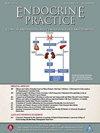肾移植后胰高血糖素样肽-1受体激动剂的益处。
IF 3.7
3区 医学
Q2 ENDOCRINOLOGY & METABOLISM
引用次数: 0
摘要
目的:胰高血糖素样肽-1受体激动剂(GLP-1 RA)对肾移植受者的益处尚未得到充分研究。方法:我们回顾性研究GLP-1RA对接受GLP-1RA治疗与未接受GLP-1RA治疗的T2DM肾移植(KT)患者的死亡率、肾脏预后和代谢参数的影响。未使用GLP-1RA治疗的KT受体参照组进行比较。数据分析采用方差分析、χ2检验和广义估计方程模型。Cox回归模型采用GLP-1 RA作为时间相关模型。对于生存分析,最后的模型拟合是按种族分层的。结果:77例T2DM患者接受GLP-1 RA治疗至少12个月。参照组包括2094名未接受GLP-1RA治疗的患者。治疗组和参照组移植时的平均(SD)年龄分别为57.9(9.5)岁和60.8(9.5)岁。参照组从治疗死亡率指标日期起的中位随访时间为1.5年(IQR 0.99, 2.4)和5.8年(IQR 3.4, 9.1)年。GLP-1 RA的使用与生存率的提高(p=0.049)、尿白蛋白与肌酐比值的降低(每年净降低10.62 mg/g, p=0.003)、eGFR下降速度的减慢(1.04 vs. 1.56 mL/min/1.73m2 /年,p=0.04)和肌钙蛋白水平的降低相关。结论:与对照组相比,T2DM患者接受KT治疗的GLP-1 RA与降低死亡率和改善肾功能相关。需要更大规模的前瞻性研究来充分评估GLP-1 RA治疗KT受体的风险和益处。本文章由计算机程序翻译,如有差异,请以英文原文为准。
Benefits of Glucagon-like Peptide-1 Receptor Agonists After Kidney Transplantation
Objective
Benefits of glucagon-like peptide-1 receptor agonists (GLP-1 RAs) in kidney transplant (KT) recipients have not been adequately studied.
Methods
We retrospectively examined the effects of GLP-1 RA on mortality, kidney outcomes and metabolic parameters in KT recipients with type 2 diabetes mellitus (T2DM) treated versus not treated with GLP-1 RA. A reference group of KT recipients not treated with GLP-1 RA was used for comparison. Data were analyzed using analysis of variance, χ2 tests, and generalized estimating equation models. GLP-1 RA was used as a time-dependent model in Cox regression modeling. For survival analysis, the final model fitting was stratified by race-ethnicity.
Results
Seventy-seven KT recipients with T2DM were treated with GLP-1 RA for at least 12 months. Reference group included 2094 patients not on GLP-1 RA. The mean (SD) age at transplant was 57.9 (9.5) and 60.8 (9.5) years for the treatment and reference groups, respectively. Median follow-up time from the index date for mortality was 1.5 (IQR 0.99, 2.4) in the treatment and 5.8 (IQR 3.4, 9.1) years in the reference group. GLP-1 RA use was associated with improved survival (P = .049), decreased urine albumin to creatinine ratio (net reduction of 10.62 mg/g per year, P = .003), slower estimated glomerular filtration rate decline (1.04 vs 1.56 mL/min/1.73 m2 per year, P = .04), and lower troponin levels.
Conclusions
GLP-1 RA in KT recipients with T2DM was associated with reduced mortality, and improved kidney function compared to the reference group. Larger, prospective studies are needed to fully evaluate the risks and benefits of GLP-1 RA therapy in KT recipients.
求助全文
通过发布文献求助,成功后即可免费获取论文全文。
去求助
来源期刊

Endocrine Practice
ENDOCRINOLOGY & METABOLISM-
CiteScore
7.60
自引率
2.40%
发文量
546
审稿时长
41 days
期刊介绍:
Endocrine Practice (ISSN: 1530-891X), a peer-reviewed journal published twelve times a year, is the official journal of the American Association of Clinical Endocrinologists (AACE). The primary mission of Endocrine Practice is to enhance the health care of patients with endocrine diseases through continuing education of practicing endocrinologists.
 求助内容:
求助内容: 应助结果提醒方式:
应助结果提醒方式:


